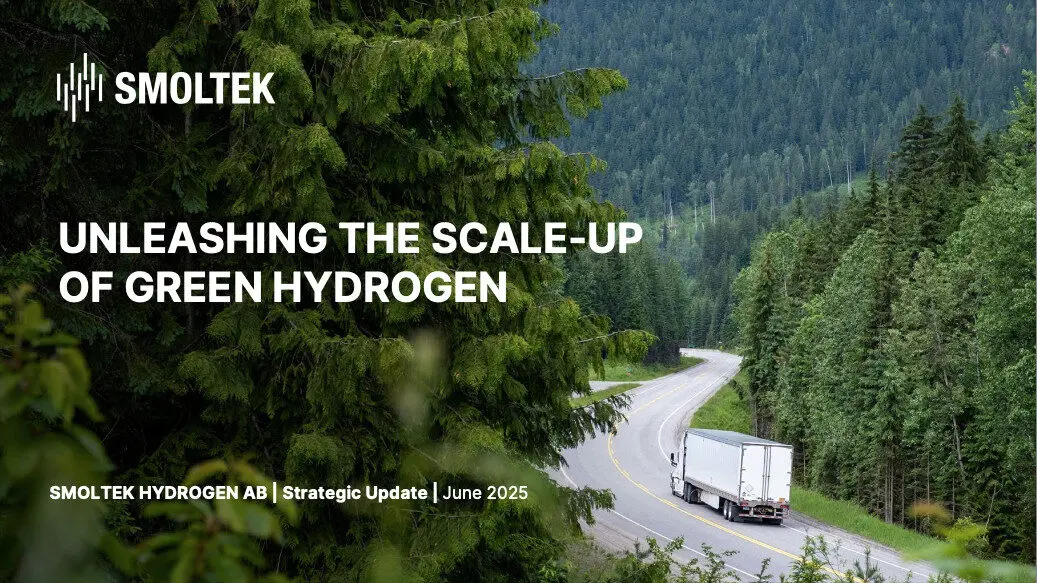Sign up for our newsletter!
Your data will be handled in compliance with our privacy policy.
Your data will be handled in compliance with our privacy policy.

Hydrogen will play a key role in a number of industries, not least in providing the industries with so-called "green electricity", as part of Europe's energy transition to climate neutrality. But someone must also produce the huge amounts of hydrogen that will be required to meet the growing needs. At the moment Smoltek Innovation AB is testing its carbon nanofiber based technology, which may drastically increase productivity in hydrogen production at a lower cost than current technology.
“A growing new area that we are looking at right now is technology for energy conversion, specifically electrolyzers for hydrogen-based energy systems, where we have already filed several patent applications,” says Ellinor Ehrnberg, head of Smoltek Innovation.
Distributed hydrogen production will play a significant role in the future, including as an infrastructure component for heavy vehicles that in the future will be powered by fuel cells, as well as in fossil-free steel production, where several Swedish projects are currently underway. More and more players are reviewing the possibilities of storing energy when other renewable energy sources such as solar, wind and water do not deliver.
The Swedish Energy Agency has, on behalf of the government, developed a national hydrogen strategy to facilitate the transition to fossil-free.
“There are many that are talking about storing and distributing hydrogen, but few are interested in modernizing the production technology,”
Ellinor Ehrnberg continues.
Of particular interest is Proton Exchange Membrane (PEM) electrolysis where the cells contain a water-absorbing electrolyte of a polymer membrane. Expensive metals such as platinum or iridium are used as catalyst materials, but these particles are placed randomly and partly hidden in current PEM cells. Smoltek’s technology enables these expensive particles to be organized to come into full contact with the membrane and thus reaches full hydrogen production with a lesser amount of expensive metals.
“Our technology should be able to produce two to three times more hydrogen per cell compared to existing technology. This is because two to three times more catalyst particles can be in contact with the membrane at the same time.”
“It is all based on the fact that our technology can grow the nanostructures in a way that gives a vertical 3D effect, which optimizes the functional surface layer. This makes our technology both economicallay and environmentally sustainable.”
Ellinor Ehrnberg explains.
In the automotive industry, it is said that perhaps 20 percent of the electric cars of the future will not be powered by batteries, but fuel cells. Especially in heavy transports, as the hydrogen reduces weight per stored energy, which makes it more suitable than a battery when you need a longer range. Ellinor Ehrnberg exemplifies with the Volvo Group, which recently formed a joint venture with Daimler Truck AG for large-scale production of fuel cells.
“This is very much something that is on the rise. The same applies, of course, to the marine and aerospace industries, where they also want to invest in sustainable, energy- dense alternatives, which are suitable for long distances and which can be stored directly in vehicles without significantly increasing weight,”
Ellinor Ehrnberg concludes.
Smoltek is still in an early research phase, Proof of concept, to demonstrate the feasibility of the technology, but since the concept is so promising and the potential market is so large, the company wants to act quickly and is now looking for partners with whom they want to realize the new electrolyzer concept.
Image: Ellinor Ehrnberg, President at Smoltek Innovation
This content is translated from an editorial ad in Ny Teknik, April 15 2021.
Your data will be handled in compliance with our privacy policy.
News

November 20, 2025
We have launched a podcast about materials technology and investments in general and our disruptive carbon nanotechnology in particular.
News

November 4, 2025
Smoltek Hydrogen has received an order for samples of low iridium-load Porous Transport Electrodes (PTE) for PEM electrolyzers. The electrodes will be used in a joint development project with Heraeus Precious Metals, a global leader in precious metals.
News

October 30, 2025
Smoltek Hydrogen recently participated in the Hydrogen Technology World Expo 2025 in Hamburg, Germany – the world’s largest industry event for innovation in hydrogen and electrolysis technology. Ellinor Ehrnberg, President of Smoltek Hydrogen, was invited to a panel discussion on the topic “Overcoming the Key Obstacles in Electrolyzer Expansion”
News

June 12, 2025
Smoltek Hydrogen is developing Smoltek PTE – a proprietary porous transport electrode based on carbon nanostructures, which is intended to meet the requirements of next-generation PEM electrolyzers for the production of fossil-free hydrogen.
News

May 20, 2025
Smoltek has been awarded a new patent within the hydrogen business area. The patent discloses a method for depositing conformally coated catalyst support for the PTL (porous transport layer) that provides both high catalytic activity and additional corrosion protection.